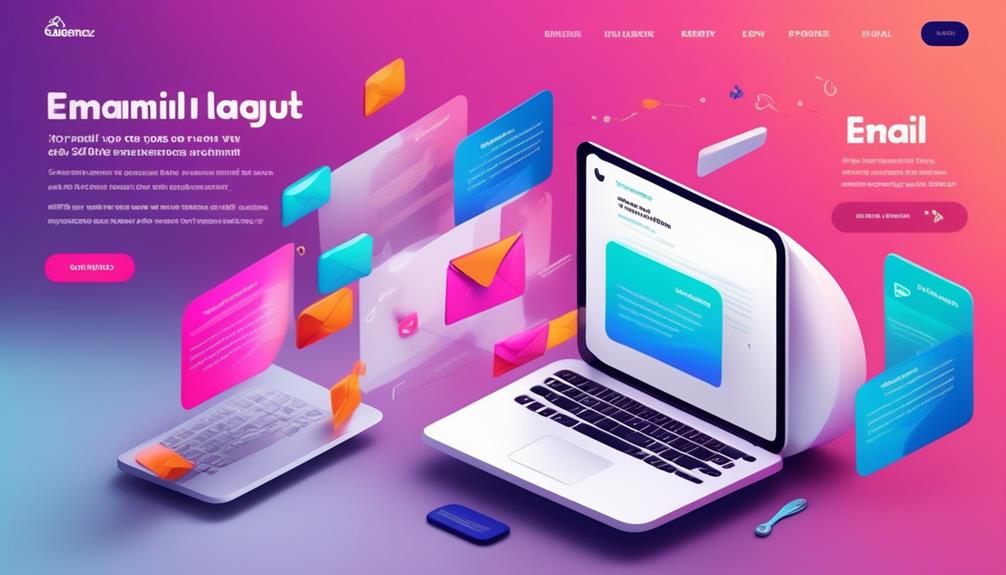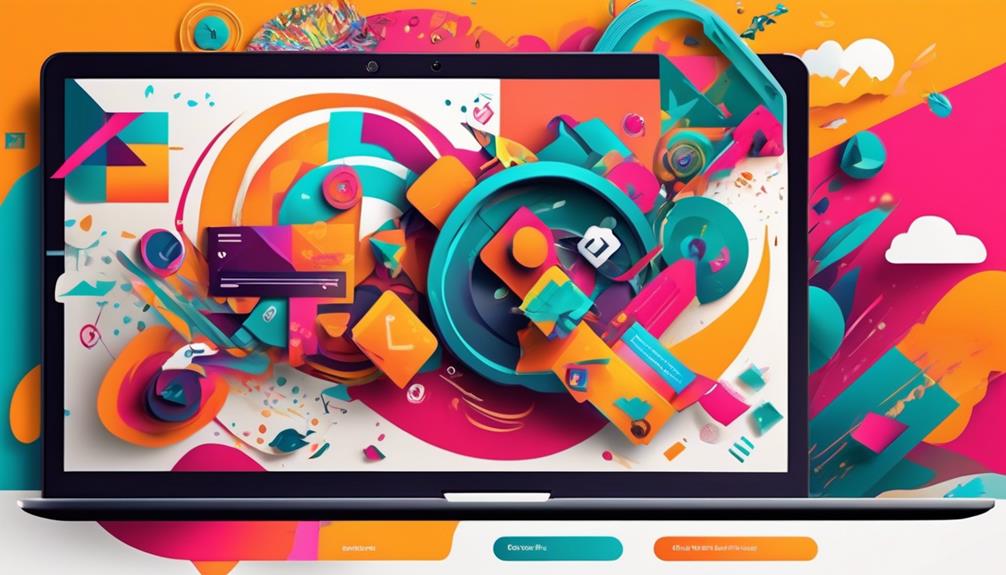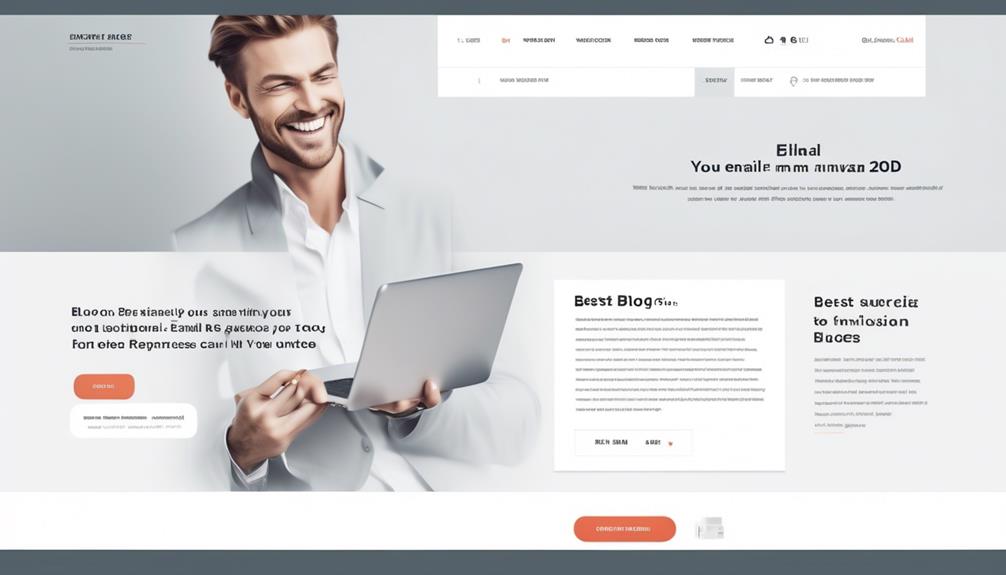In the field of email design, the year 2024 is on track to be an exciting time as we delve into new trends and techniques to captivate our audience. By integrating interactive elements and strategically utilizing customized visuals, email design is evolving to create stronger bonds and provide more personalized experiences for email recipients.
As we explore the top email design practices for 2024, it’s clear that a focus on creativity and visual appeal will be paramount. But what specific strategies and approaches will set the stage for successful email campaigns in the coming year?
Join us as we unravel the key components that will shape the landscape of email design in 2024.
Key Takeaways
- Choose a sender name that is personal, relevant, and concise to increase email open rates.
- Craft compelling and concise subject lines, utilizing emojis strategically to stand out.
- Create visually striking headers with contrasting colors and ample white space to capture attention.
- Utilize dynamic content and user segmentation to personalize emails and increase engagement and conversion rates.
Sender Name
In crafting email designs for 2024, the sender name plays a pivotal role in capturing the recipient’s attention and driving open rates. When it comes to email marketing best practices, the sender name is a crucial element in establishing a connection with the audience.
Research indicates that 68% of people decide whether to open an email based on the sender name. To maximize open rates, it’s essential to choose a sender name that’s personal, relevant, and concise. Avoid using only a staff member’s name, as it may not be memorable. Instead, consider combining it with the company’s name for instant recognition.
Opt for sender names that evoke trust and familiarity, potentially leading to higher engagement. Furthermore, a well-chosen sender name can contribute to consistent branding and build trust with subscribers.
Subject Line
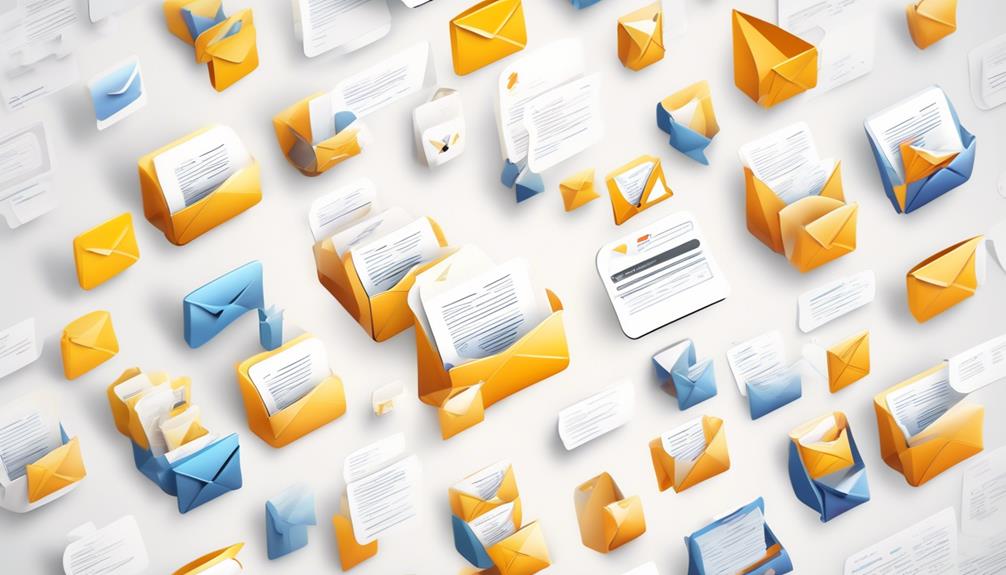
Craft a compelling and concise subject line to captivate the recipient’s attention and drive high open rates for your emails. In line with email design trends, incorporating catchy subject lines is essential.
Utilize emojis strategically to add visual content and stand out in crowded inboxes, increasing open rates.
Transparency and honesty in the subject line are crucial for building trust with recipients.
Creating curiosity through the subject line can pique the interest of the audience, prompting them to open the email.
Personalization is key, as personalized subject lines resonate more with specific audiences, thus improving open rates.
Additionally, incorporating dynamic content and Gen Z slang where appropriate can make the subject line more engaging and relatable to younger audiences.
Preheader
Following the captivating subject line, the preheader serves as a succinct preview of the email’s content, enticing recipients to engage further. Incorporating the best email design practices for 2024, the preheader plays a crucial role in enhancing the user experience and driving email open rates.
Here are some key elements to consider when optimizing the preheader:
- Concise and Compelling Text: Keep the preheader text between 30 and 70 characters to ensure it’s displayed fully on various devices. Use compelling language to entice recipients to open the email and explore its content.
- Personalization and Value Addition: Personalizing the preheader text and ensuring it adds value or context to the email content can significantly enhance engagement. Consider using recipient’s name or location to make the preheader more relevant and appealing.
- Complementary to Subject Line: The preheader should complement the subject line and provide additional information or context. This cohesive approach extends the impact of the subject line, increasing the likelihood of recipients engaging with the email.
Incorporating these elements into the preheader as part of the overall email design strategy can contribute to a more engaging and successful email campaign. By carefully considering the colors, text, and email content within the preheader, businesses can enhance the overall user experience and drive better results.
Header
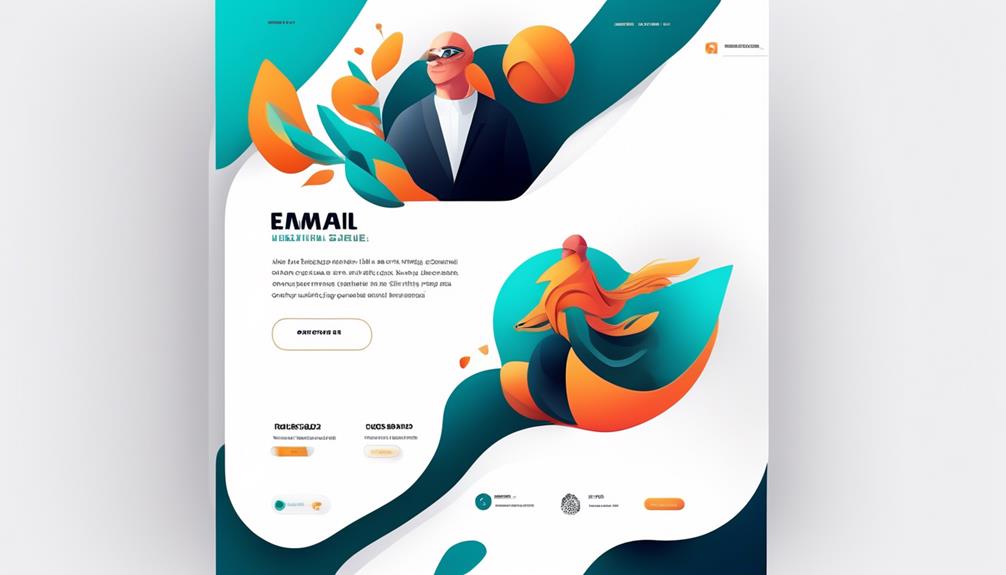
When it comes to email design, the header plays a crucial role in grabbing the reader’s attention.
It sets the visual hierarchy, ensures mobile responsiveness, and maintains accessibility compliance.
These are the key points we’ll be discussing in relation to crafting an effective and engaging email header.
Visual Hierarchy
Creating a visually striking header is essential in email design to immediately capture the reader’s attention and set the tone for the content that follows. When it comes to visual hierarchy in the header, there are several key elements to consider:
- Strategic Use of Color and White Space: Utilize contrasting colors and ample white space to draw attention to the most important elements in the header.
- Placement of Design Elements: Carefully position images, text, and logos to guide the reader’s eye towards the key message and call-to-action.
- Enhancing User Engagement: Incorporate design elements that encourage interaction, such as buttons or animated graphics, to boost user engagement.
Mobile Responsiveness
To ensure optimal user experience across devices, it’s crucial to make the header mobile-responsive. Utilize email marketing software with a user-friendly drag and drop design tool to create a mobile-responsive header.
Implement a single-column layout in the header, optimizing images and text size for mobile viewing. Test the header’s display on various mobile devices and email clients to ensure compatibility.
Keep the header concise and visually appealing, using geometric shapes and an HTML email format to create responsive emails.
Accessibility Compliance
How can we ensure that the email header is designed to be accessible for all users, including those with disabilities?
Ensuring accessibility compliance for the email header is crucial for inclusive email design practices. Here are three essential steps for achieving accessibility compliance in the email header:
- Use semantic HTML and proper structuring to make the header content easily navigable for screen readers and other assistive technologies.
- Provide descriptive alt text for header images to convey their content and purpose to visually impaired users.
- Maintain a color palette and sufficient white space that meets accessibility standards, improving readability for all users.
Email Copy

Crafting compelling email copy is essential for capturing and maintaining reader interest in 2024. The language used in email campaigns should resonate with the target audiences and reflect the brand voice. It’s crucial to keep the email copy concise, engaging, and under 200 words to ensure it appeals to readers.
When crafting email copy, it’s important to utilize simple, on-brand, and easy-to-read fonts to maintain brand identity. Limiting the number of fonts used to a maximum of two and prioritizing the use of sans serif fonts in body text can enhance readability.
Additionally, incorporating high-resolution images in PNG format under 1MB can make the email visually appealing. It’s also essential to consider the color palette, ensuring it’s consistent with the brand and using contrasting colors to highlight sections. Alt text for images should be included to ensure accessibility.
Images
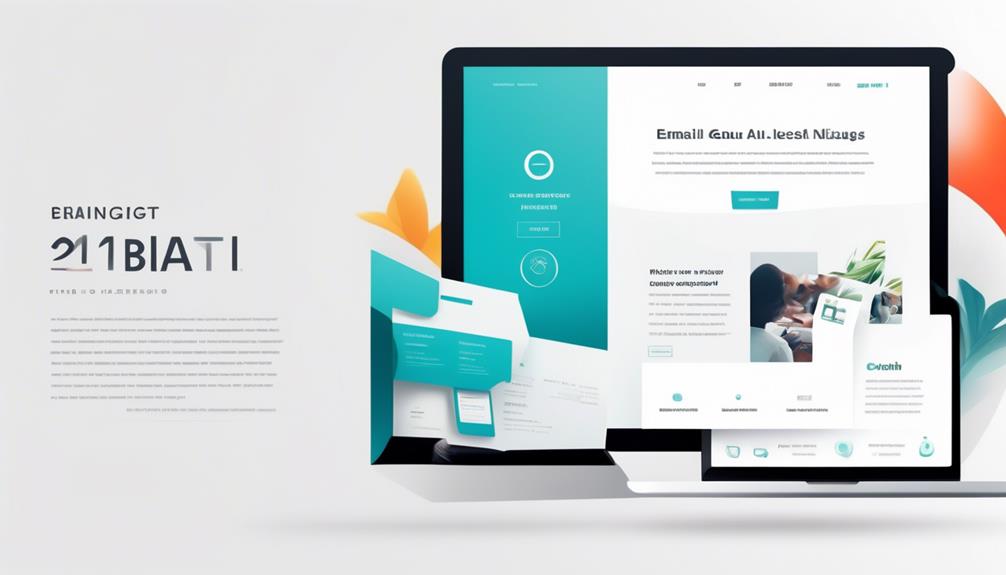
When selecting images for email campaigns, it’s crucial to choose high-resolution ones in PNG format, each serving a strategic purpose and complementing the overall design to capture and maintain reader interest.
Here are three essential considerations for adding images to your email templates:
- High-resolution and PNG Format: Opt for high-resolution images in PNG format, ensuring they’re under 1MB in size. This helps maintain image quality without sacrificing email load times.
- Strategic Purpose: Each image should serve a specific purpose, whether it’s showcasing a product, conveying a message, or evoking an emotional response from the audience. The images should seamlessly integrate with the content and design of the email.
- Complementary Colors and Fonts: When designing emails, ensure that the colors and fonts within the images align with your overall branding and email design. This creates a cohesive look and enhances the visual appeal of your emails.
Colors
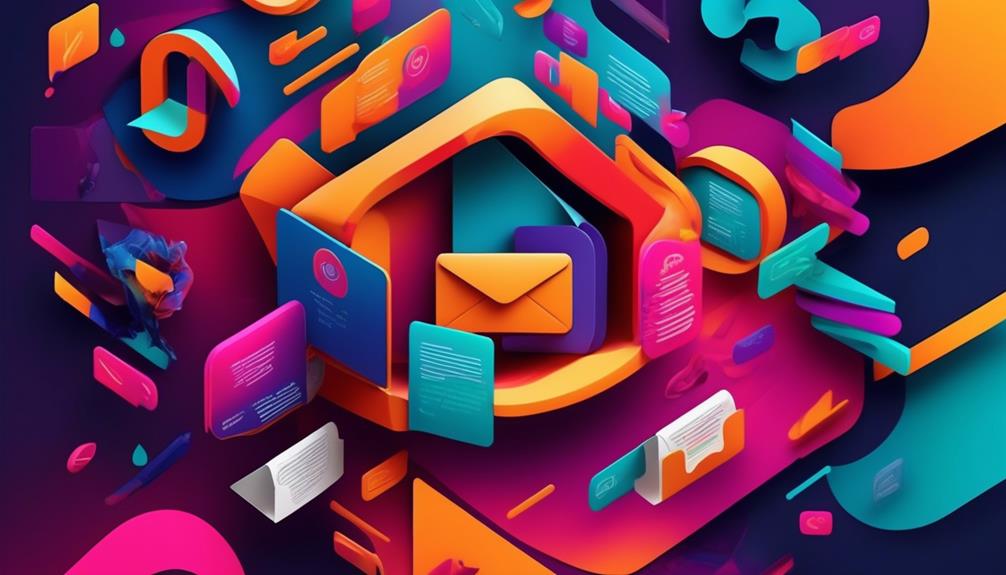
Let’s talk about the impact of color choices in email design.
We’ll explore how color psychology can influence recipient behavior and perception.
Additionally, we’ll consider accessibility considerations and the importance of maintaining brand consistency in our color choices.
Color Psychology
Understanding the impact of color psychology in email design is vital for evoking specific emotions and responses from recipients. When considering color psychology in email design, it’s essential to:
- Choose colors that align with the brand and the intended emotional response, ensuring they display well across various email clients like Gmail and Outlook.
- Use contrasting colors to highlight important content in emails while adhering to the brand’s color palette.
- Ensure that background and text colors complement each other for readability, avoiding the use of too many colors in a single email.
Accessibility Considerations
Considering the impact of color psychology on email design, it’s crucial to also prioritize accessibility considerations, particularly regarding color choices and contrast for optimal readability and inclusivity. When designing emails, we must use a defined brand color palette and ensure high color contrast for text and background to improve email accessibility. Avoid relying solely on color to convey important information; use additional visual cues or text labels for color-coded elements. It’s important to make sure that the colors used in emails are accessible to individuals with color vision deficiencies. Testing emails with accessibility tools can ensure that color combinations are readable and compliant with accessibility standards. Additionally, providing options for users to customize color settings within emails can accommodate individual preferences and accessibility needs.
| Consideration | Description | Example |
|---|---|---|
| Dark mode compatibility | Ensure emails are readable in both light and dark modes to accommodate user preferences and improve accessibility. | Adapting color schemes for dark mode compatibility. |
| Subject Lines | Use of high color contrast to make subject lines stand out and improve readability, especially for users with visual impairments. | Using bold and contrasting colors for subject lines. |
| Use of white space | Utilize white space to enhance color contrast and readability, making the content more accessible and visually appealing. | Incorporating ample spacing around text and images. |
Brand Consistency
To maintain a cohesive visual identity across emails, we consistently utilize our brand’s color palette in headers, buttons, and other design elements. This approach reinforces brand consistency and association, enhancing brand recognition and the overall look and feel of our marketing emails.
When incorporating color schemes, we ensure that they complement each other and don’t overwhelm the reader with too many colors, prioritizing readability and visual appeal.
Additionally, we strategically employ contrasting colors to highlight essential sections and call-to-action buttons, effectively drawing attention to key elements. By implementing color psychology, we evoke specific emotions or associations aligned with our brand’s messaging and objectives, creating a more impactful and memorable experience for our audience.
Call To Action
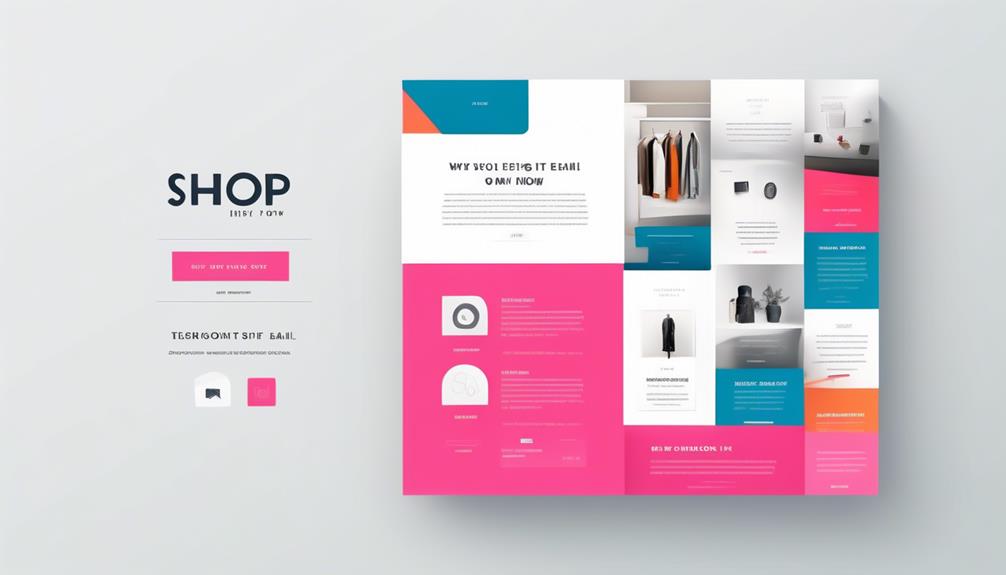
When crafting email designs, we prioritize creating a clear and compelling Call To Action (CTA) to encourage our readers to take specific actions.
A well-designed CTA is crucial for converting email recipients into customers or leads.
To optimize the effectiveness of CTAs, email marketers should strategically place them in the email to attract attention and drive engagement.
Visual appeal and contrasting colors can make the CTA stand out, leading to increased click-through rates.
Additionally, utilizing action-oriented language in the CTA can motivate readers to take the desired action.
As email service providers offer increasingly sophisticated tools, A/B testing can help determine the best time to send emails and optimize the placement and design of CTAs.
Footer
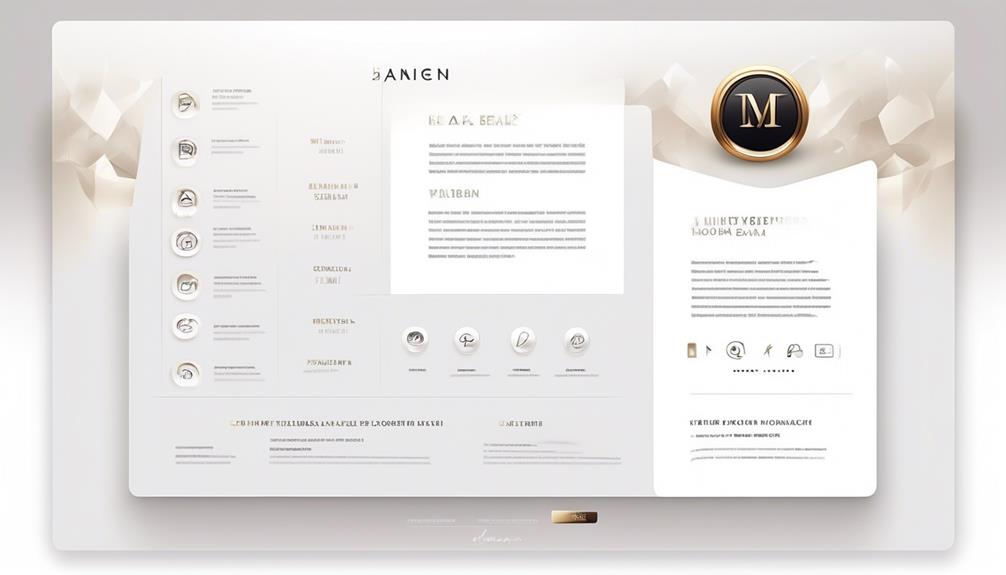
Our email designs prioritize a comprehensive and impactful footer, ensuring that readers have access to essential contact information and options while reinforcing our brand’s identity and values. The footer is often overlooked but plays a crucial role in our email stand.
Here’s what we include in our footer to enhance the email readers’ experience:
- Contact Information: We provide our email address and physical address in the footer to ensure that readers have easy access to reach out to us if needed.
- Unsubscribe Link: It’s essential to include a clear and easy-to-find link to unsubscribe from future emails. This not only complies with regulations but also helps maintain a positive relationship with our audience.
- Brand Reinforcement: Our footer creatively incorporates our unique selling proposition, core brand values, company slogan, store locations, and even special coupon codes. This reinforces our brand’s identity and provides added value to the readers.
Personalization
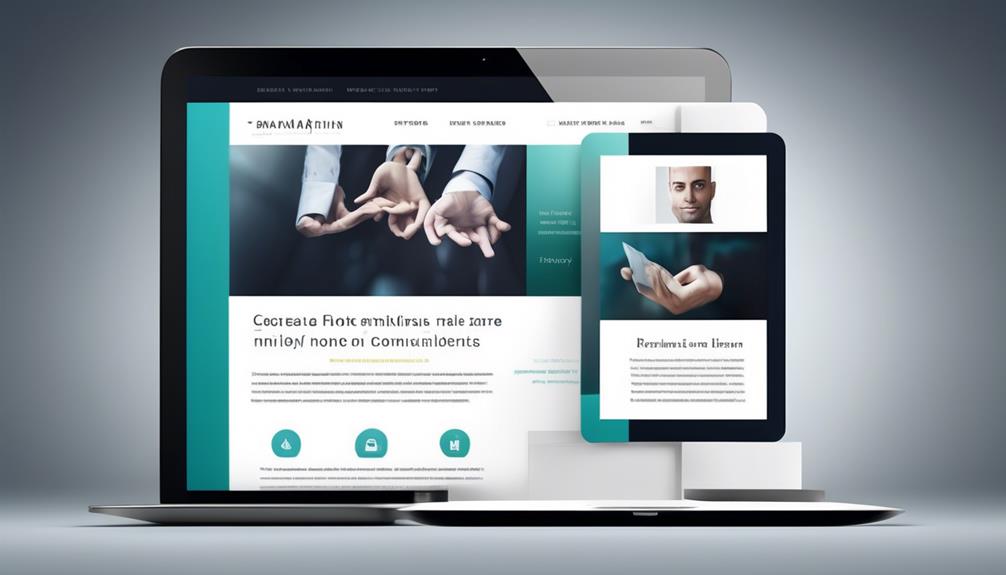
Personalization in email design is crucial for connecting with our audience on a more individual level.
By utilizing dynamic content and user segmentation, we can tailor our emails to provide relevant and personalized experiences for each recipient.
This approach not only increases engagement but also contributes to higher open and click-through rates.
Dynamic Content
Enhancing email engagement and conversion rates, dynamic content (personalization) tailors email content to individual recipients’ preferences and behaviors. Here’s how dynamic content can be optimized:
- Utilize Email Builders: Incorporate dynamic content features offered by email builders to easily personalize emails based on user data and interactions.
- Integrate with Social Media: Leverage dynamic content to pull in social media posts or user-generated content, creating a more engaging and personalized email experience.
- Implement Countdown Timers: Use dynamic content to include countdown timers for limited-time offers, creating a sense of urgency and driving higher conversion rates.
User Segmentation
Utilizing user segmentation allows for personalized email content tailored to individual recipients’ demographics, behavior, and interactions, enhancing engagement and relevance. By dividing your audience into specific segments based on factors such as age, location, purchase history, or email engagement, you can create targeted and relevant content that resonates with each group.
This targeted approach can significantly increase your open and click-through rates, ultimately leading to higher conversion and retention. With years of experience in the email landscape, we’ve seen user segmentation become a popular email marketing strategy, allowing brands to provide a seamless and personalized experience for their subscribers.
Incorporating user segmentation into your email marketing strategy can help you deliver the right message to the right audience at the right time, driving better results and fostering stronger customer relationships.
Layout
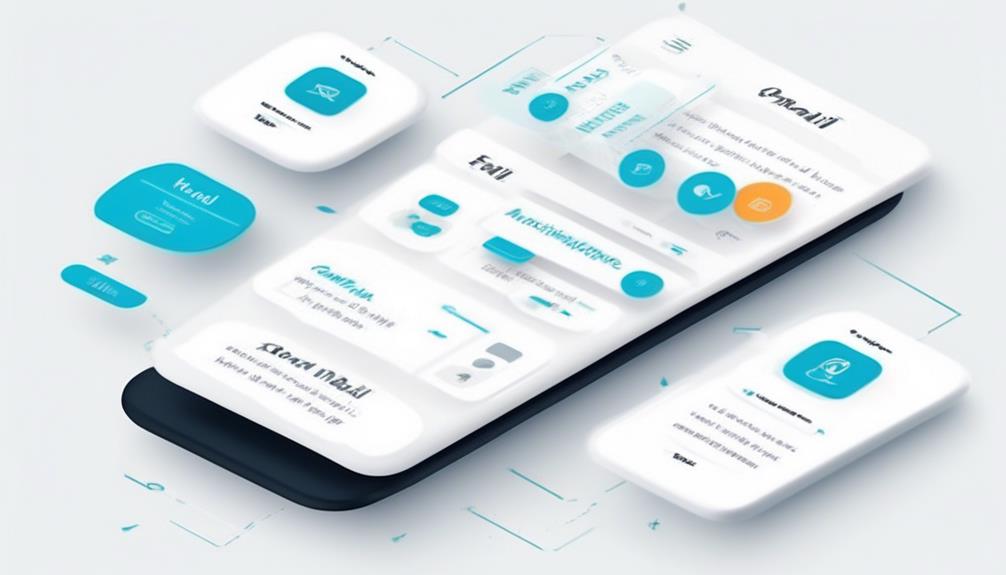
When designing email layouts for 2024, it’s essential to prioritize a responsive template that ensures optimal display across various devices. To achieve an effective layout, we should consider the following:
- Simplicity and Clutter-Free Design: A simple and uncluttered layout enhances readability and ensures a seamless reading flow for recipients. Avoid overcrowding the email with excessive images or text, and strategically use white space to guide the reader’s focus.
- Strategic CTA Placement: The layout should strategically add Call-to-Action (CTA) buttons or links to direct user engagement. Placing CTAs where they’re easily visible and accessible can significantly improve click-through rates and conversions.
- Color Usage: Incorporate a maximum of two colors in the layout, including bright colors strategically to draw attention to essential elements such as CTA buttons or important information. A balanced and thoughtful use of color can enhance the visual appeal of the email without overwhelming the recipient.
Mobile-Responsive

Incorporating mobile-responsive design into email layouts ensures that recipients can seamlessly engage with the content on various devices, maintaining readability and user experience. Mobile-responsive design is essential for optimizing emails for mobile viewing and interaction. It involves using a single-column layout, larger fonts, and touch-friendly elements to enhance readability and usability on small screens. Additionally, optimizing images and testing emails across different mobile devices ensures compatibility. Utilizing a responsive email template is crucial for providing an optimal display on smartphones and tablets. Designing emails with mobile responsiveness in mind can significantly improve user experience and engagement for mobile users.
| Mobile-Responsive Design | |
|---|---|
| Single-column layout | Larger fonts for readability |
| Touch-friendly elements | Image optimization for compatibility |
A/B Testing
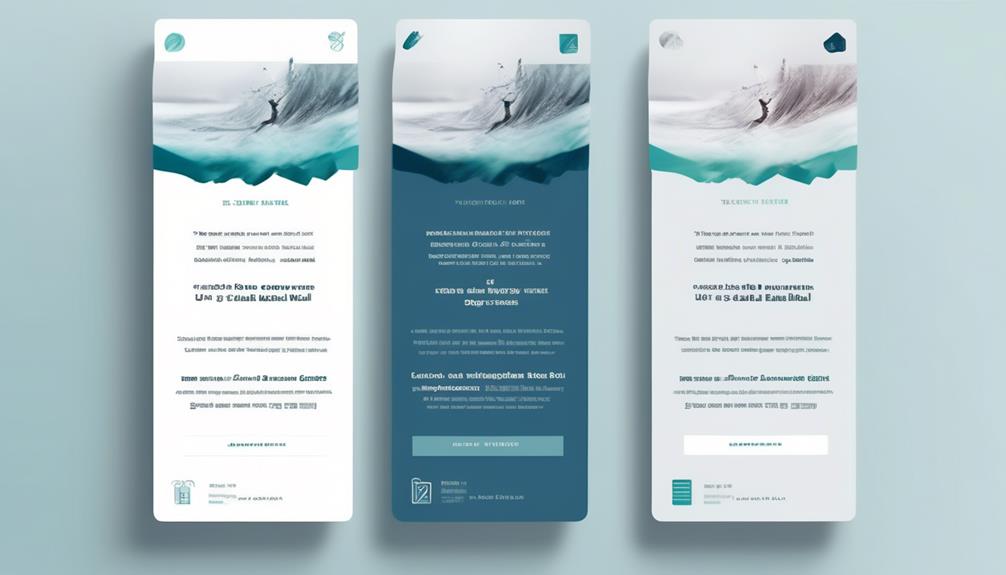
A fundamental practice for optimizing email performance and enhancing subscriber engagement is A/B testing, which involves comparing two versions of an email to determine the more effective design elements.
Here are three key aspects of A/B testing:
- Optimizing Content: A/B testing allows us to compare different types of content, such as text, images, and videos, to see which resonates better with the audience. It helps in understanding what kind of content is more likely to engage subscribers and prompt them to take action.
- Refining Call-to-Action (CTA): Through A/B testing, we can experiment with different CTAs, such as button colors, text, and placement, to determine the most effective way to point readers toward the main message or desired action. This ensures that the CTA stands out and encourages conversions.
- Subject Line and Preview Text: Marketers use A/B testing to refine subject lines and preview text to make sure they effectively capture attention and communicate the value of the email content. This is crucial for increasing open rates and ensuring that the main message gets across to the audience.
A/B testing is a vital tool for optimizing email design and content, ultimately leading to good engagement and conversion rates.
What Are the Key Trends in Email Design Practices for 2024?
In 2024, the best email design practices are expected to focus on interactive elements, personalized content, and mobile optimization. Businesses will prioritize creating visually appealing emails with clear CTAs and minimalistic designs. AI-driven personalization will also play a crucial role in enhancing user engagement and driving email marketing success.
Frequently Asked Questions
What Is the Email Trend in 2024?
In 2024, email trends are all about engaging content, dark mode designs, exclusive visuals, friendly faces, and gamified emails.
These practices create a sense of connection, warmth, and exclusivity, while also improving engagement and understanding.
It’s an exciting time for email design, as we explore new ways to captivate and connect with our audiences.
What Is the Best Email Layout?
Creating a captivating email layout involves balancing aesthetics and functionality. We prioritize a visually appealing design that fosters user engagement. Incorporating clear hierarchies, compelling imagery, and concise copy enhances readability and retention.
Employing responsive design ensures seamless viewing across devices. Strategically placing CTAs and an easy-to-find unsubscribe button maximizes interaction and compliance.
What Are the Trends for Newsletters in 2024?
Trends for newsletters in 2024 are exciting!
Interactive content like GIFs and videos is boosting engagement.
Dynamic personalized content based on user behavior is on the rise.
Dark mode email designs and customized visuals are gaining traction.
Nostalgic design elements and mixed media collages are creating immersive experiences.
These trends are reshaping the email landscape and enhancing user experiences.
Is Email Marketing Still Relevant in 2024?
Yes, email marketing is still relevant in 2024. We engage subscribers, boost open rates, and improve brand recognition.
Personalizing emails, optimizing for mobile, and embracing design trends are crucial. Interactive content, dark mode compatibility, and visual storytelling are key trends.
AI-powered tools, enhanced security, and privacy features are shaping the future. We prioritize mobile-first design and dark mode compatibility to stay ahead in email marketing.
Conclusion
In conclusion, email design practices for 2024 will be all about engaging and captivating the audience.
Like a colorful and dynamic painting, emails will incorporate interactive elements, personalized visuals, and vibrant colors to enhance brand identity and drive engagement.
By focusing on creating visually appealing and interactive content, email designs in 2024 will aim to leave a lasting impression on the audience.
